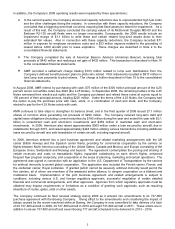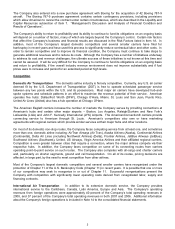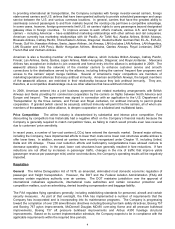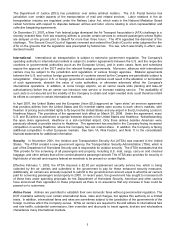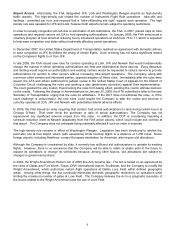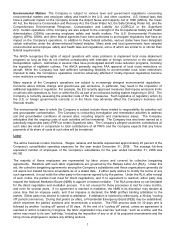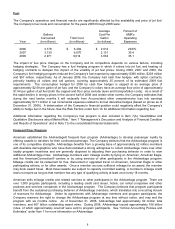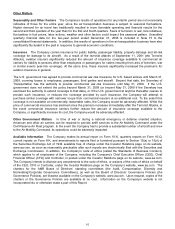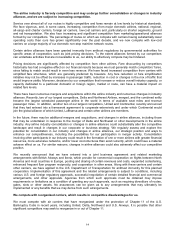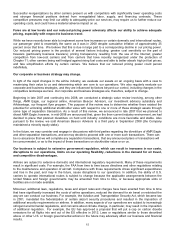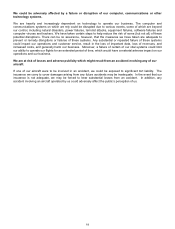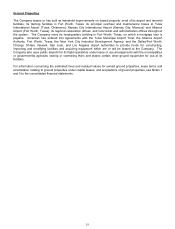American Airlines 2008 Annual Report Download - page 14
Download and view the complete annual report
Please find page 14 of the 2008 American Airlines annual report below. You can navigate through the pages in the report by either clicking on the pages listed below, or by using the keyword search tool below to find specific information within the annual report.11
ITEM 1A. RISK FACTORS
Our ability to become profitable and our ability to continue to fund our obligations on an ongoing basis will depend
on a number of risk factors, many of which are largely beyond our control. Some of the factors that may have a
negative impact on us are described below:
As a result of significant losses in recent years, our financial condition has been materially weakened.
We incurred significant losses in 2001-2005, which materially weakened our financial condition. We lost
$857 million in 2005, $751 million in 2004, $1.2 billion in 2003, $3.5 billion in 2002 and $1.8 billion in 2001.
Although we earned a profit of $504 million in 2007 and $231 million in 2006, we lost $2.1 billion in 2008 (which
included a $1.1 billion impairment charge). Because of our weakened financial condition, we are vulnerable both to
the impact of unexpected events (such as terrorist attacks or spikes in jet fuel prices) and to deterioration of the
operating environment (such as a deepening of the current global recession or significant increased competition).
The severe global economic downturn has resulted in weaker demand for air travel and lower investment asset
returns, which may have a significant negative impact on us.
We are experiencing significantly weaker demand for air travel driven by the severe downturn in the global
economy. Many of the countries we serve are experiencing economic slowdowns or recessions. We began to
experience weakening demand late in 2008, and this weakness has continued into 2009. We reduced capacity in
2008, and we recently announced further reductions to our 2009 capacity plan. If the global economic downturn
persists or worsens, demand for air travel may continue to weaken. No assurance can be given that capacity
reductions or other steps we may take will be adequate to offset the effects of reduced demand.
The economic downturn has resulted in broadly lower investment asset returns and values, and our pension
assets suffered a material decrease in value in 2008 related to broader stock market declines, which will result in
higher pension expense and potentially higher required contributions in future years. In addition, under these
unfavorable economic conditions, we may also be required to maintain substantial cash reserves under our credit
card processing agreements. These issues individually or collectively may have a material adverse impact on our
liquidity. Also, disruptions in the capital markets and other sources of funding may make it impossible for us to
obtain necessary additional funding or make the cost of that funding prohibitive.
We face numerous challenges as we seek to maintain sufficient liquidity, and we will need to raise
substantial additional funds. We may not be able to raise those funds, or to do so on acceptable terms.
We have significant debt, lease and other obligations in the next several years, including significant pension
funding obligations. For example, in 2009 we will be required to make approximately $1.8 billion of principal
payments on long-term debt and approximately $110 million in principal payments on capital leases, and we
expect to make approximately $1.6 billion of capital expenditures. In addition, the global economic downturn,
potential increases in the amount of required reserves under credit card processing agreements, and the
obligation to post cash collateral on fuel hedging contracts have negatively impacted, or may in the future
negatively impact, our liquidity. To meet our commitments and to maintain sufficient liquidity as we continue to
implement our restructuring and cost reduction initiatives, we will need continued access to substantial additional
funding. While we have arranged financing that, subject to certain terms and conditions, covers a majority of our
2009 aircraft deliveries and have arranged backstop financing which could be used for a significant portion of our
remaining 2009 - 2011 Boeing 737-800 aircraft deliveries, we will also need to raise additional funds to meet our
commitments to purchase aircraft and execute our fleet replacement plan.
Our ability to obtain future financing is limited by the value of our unencumbered assets. A very large majority of
our aircraft assets (including most of our aircraft eligible for the benefits of Section 1110 of the U.S. Bankruptcy
Code) are encumbered. Also, the market value of our aircraft assets has declined in recent years, and may
continue to decline.
Since the Terrorist Attacks of September 2001, our credit ratings have been lowered to significantly below
investment grade. These reductions have increased our borrowing costs and otherwise adversely affected
borrowing terms, and limited borrowing options. Additional reductions in our credit ratings might have other effects
on us, such as further increasing borrowing or other costs or further restricting our ability to raise funds.



